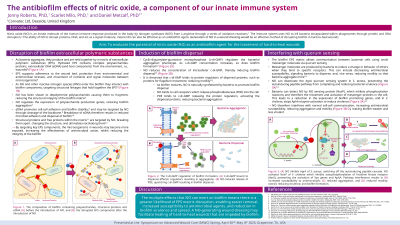Practice Innovations
(PI-028) The Antibiofilm Effects of Nitric Oxide, a Component of Our Innate Immune System
Friday, May 2, 2025
7:45 PM - 8:45 PM East Coast USA Time

Scarlet Milo, PhD – R&D Program Advisor, Advanced Wound Care R&D, Convatec Ltd; Jonathan Roberts, PhD – R&D Scientist, Advanced Wound Care R&D, Convatec Ltd
Introduction: Hard-to-heal wounds, such as diabetic foot ulcers, pose a significant clinical challenge, resulting in poor patient quality of life and substantial economic burden. The aim of this review was to evaluate the evidence of nitric oxide (NO) as an antibiofilm agent and assess the potential of a novel NO-generating wound dressing technology* in managing these complex surface-associated and aggregated microbial communities. Biofilm frequently develops in hard-to-heal wounds and contributes to wound inflammation, delayed healing, and increased risk of local infection. Due to the tolerance of biofilm the host immune response, antibiotic treatments, and standard antimicrobial dressings, there is a clinical need for wound treatments able to effectively target biofilm in hard-to-heal wounds. NO represents one such strategy, due to its capacity to target specific mechanisms integral to biofilm survival.
Methods: We conducted a narrative review of the evidence underlying the antibiofilm effects of NO, and discussed its potential as an antibiofilm agent for the management of hard-to-heal wounds.
Results: Key antibiofilm mechanisms of action were identified and reviewed. NO induces biofilm dispersal, exposing bacteria, making them more susceptible to antimicrobial agents. NO disrupts intra-biofilm bacterial communication, resulting in reduced virulence of biofilm bacteria and thus the extent and severity of colonization and infection. Reactive nitrogen species (RNS) may destabilize the biofilm matrix via depolymerization of polysaccharides and cleavage of extracellular DNA, enabling increased penetration of NO and antimicrobial agents to reach the microorganisms within.
Discussion: The antibiofilm effects of NO substantiate its potential in wound care. For example, a novel NO-generating wound dressing technology* may represent a promising strategy for the management of surface-associated/aggregated microbial communities and infection in hard-to-heal wounds.
Methods: We conducted a narrative review of the evidence underlying the antibiofilm effects of NO, and discussed its potential as an antibiofilm agent for the management of hard-to-heal wounds.
Results: Key antibiofilm mechanisms of action were identified and reviewed. NO induces biofilm dispersal, exposing bacteria, making them more susceptible to antimicrobial agents. NO disrupts intra-biofilm bacterial communication, resulting in reduced virulence of biofilm bacteria and thus the extent and severity of colonization and infection. Reactive nitrogen species (RNS) may destabilize the biofilm matrix via depolymerization of polysaccharides and cleavage of extracellular DNA, enabling increased penetration of NO and antimicrobial agents to reach the microorganisms within.
Discussion: The antibiofilm effects of NO substantiate its potential in wound care. For example, a novel NO-generating wound dressing technology* may represent a promising strategy for the management of surface-associated/aggregated microbial communities and infection in hard-to-heal wounds.

.jpg)